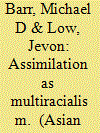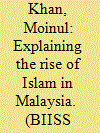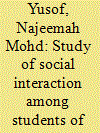| Srl | Item |
| 1 |
ID:
072651


|
|
|
|
|
| Publication |
2005.
|
| Summary/Abstract |
The myths of meritocracy and multiracialism 'explain' between them both the 'fairness' of the Singapore system and the subordinate role of the non-Chinese minority races. They also purport to assure the minorities that they enjoy full status as members of the nation-building project and that their cultural and religious mores are embraced and protected within its framework. Using the Malay minority as its case study, and arguing from archival, oral, official government and secondary sources, this paper argues that the Singapore systems of meritocracy and multiracialism have not been concerned primarily with intercommunal tolerance since the 1970s, but are now programmes of assimilation of the racial minorities into a Chinese-dominated society.
|
|
|
|
|
|
|
|
|
|
|
|
|
|
|
|
| 2 |
ID:
132380


|
|
|
|
|
| Publication |
2013.
|
| Summary/Abstract |
Malaysia, since the 1970s, saw a trend of increasing adoption of Islamic values both at private and public levels, often referred to as the Islamic resurgence. This has led to an academic interest whether this upsurge of Islam in that country has been driven mainly by Islamic ideology that aims at establishing a universal Islamic order or other circumstances specific to Malaysia. This paper seeks to provide an illuminating explanation to this riddle. Having reviewed the trends of Islamic profile and the main reasons behind it, this paper finds that the ethnic conflict over material interests between the local Malays and non-Malays, political rivalry between two main parties, UMNO and PAS and the consequences of widening gap between the rich and the poor as a result of massive economic programmes, have all prompted the urge for mounting Islamic profile. Had there been no such competition, Islam would have remained marginalised as happened till the 1970s. However, in later times, Islam came as a means or instrument to express discontent by these competing interest groups towards each other. The key element of this analysis is to show that it is context that has largely stimulated the profile of Islam in Malaysia rather than eagerness, the inherent association with Islamic ideology, to establish an Islamic state and a universal order. Findings of this paper reinforce the view that Islam is not necessarily one and uniform and is not essentially linked to politics of ruling and resisting.
|
|
|
|
|
|
|
|
|
|
|
|
|
|
|
|
| 3 |
ID:
109852


|
|
|
|
|
| Publication |
2012.
|
| Summary/Abstract |
The purpose of this study is to examine the social interaction among students of various ethnic groups at Vision Schools in Malaysia. The focus is mainly on Malays, Chinese and Indians with a sample size of 642 students. This research applies the quantitative and qualitative approach. For the qualitative approach, the researcher used focus group interviews and observations to examine social interaction among students of various ethnic groups. In this research there is one independent variable to explain and predict eleven independent variables. Hypotheses were analysed using post-hoc and multivariate analysis at a p < 0.05 significance level. Findings of the study indicated there were significant difference in the mean score levels for all the independent variables. Study showed high social distance scale for Malay and Chinese students. All the dependent variables effected social interaction among students. Based on the results various suggestions have been recommended and it is hoped that these suggestions will help those involved in teaching and learning to have a better understanding concerning social interaction among Malay, Chinese and Indian students at Vision Schools in Malaysia.
|
|
|
|
|
|
|
|
|
|
|
|
|
|
|
|